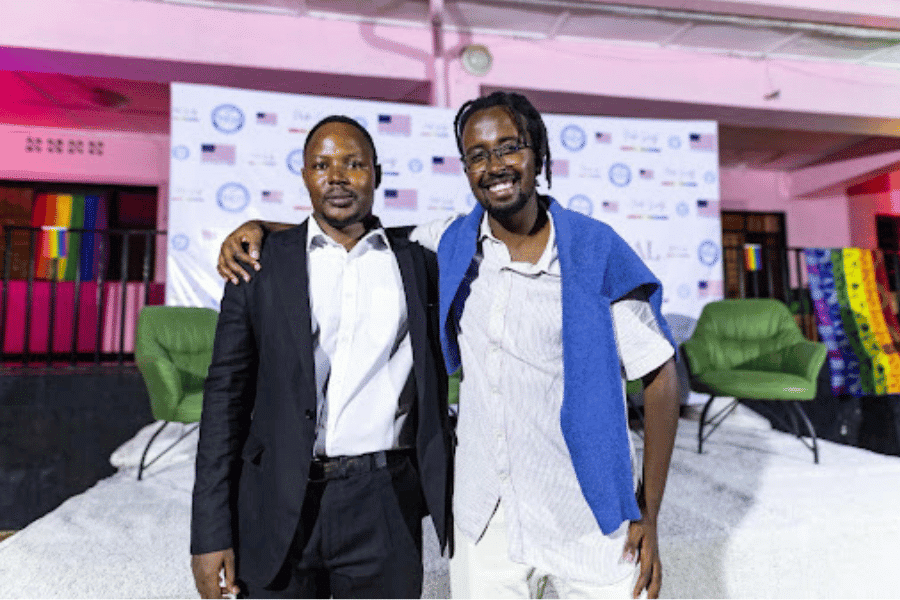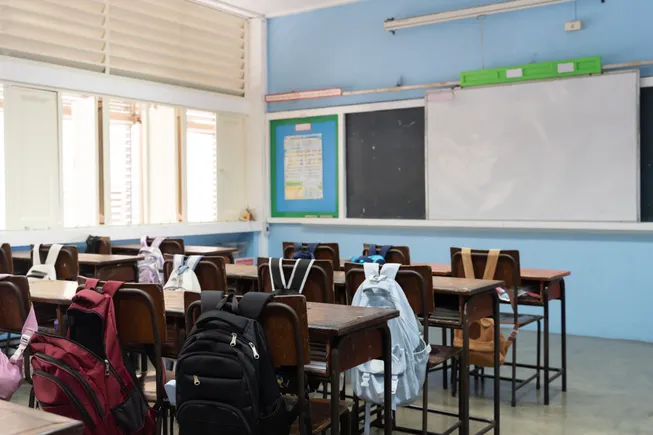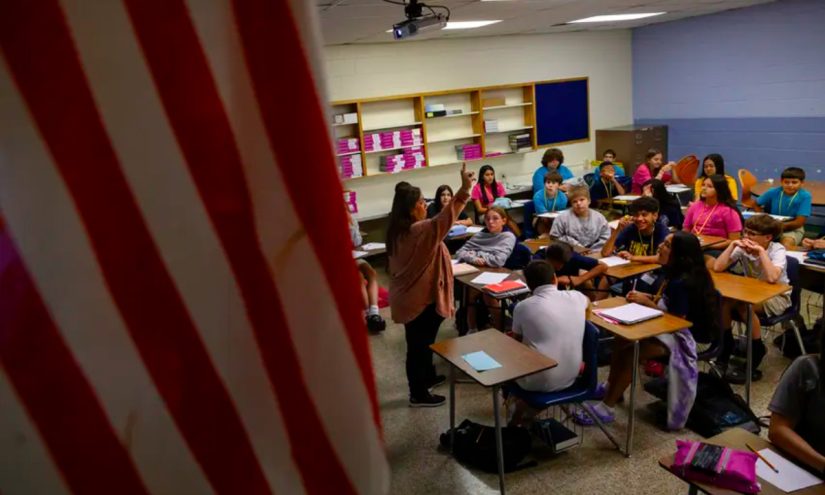

Around the world, Queer rights are being challenged, attacked and denied. Governments are cutting budgets for important health and other programmes.
But in parts of Africa, there are distinct signs of progress. Organizations that serve and advocate for Queer communities in Eastern Africa now see hope for the future. That’s the case even in Uganda where “aggravated homosexuality” has carried the death penalty since 2023.
“It is still a very hard environment but we are doing much better than a lot of people think,” said Brian Aliganyira, founder and executive director of the Ark Wellness Hub, an organization based in Kampala, Uganda, that helps LGBT community members who have difficulty accessing health services in public hospitals due to both anti-Queer laws and ongoing community stigma and discrimination.
“We are doing better in terms of fighting back and supporting communities, not necessarily better in terms of protection, rights and freedoms,” Aliganyira said.
In Kenya, homosexual acts are illegal. Rodney Otieno, who is the co-founder and policy director for the Queer & Allied Chamber of Commerce Africa of Nairobi (QACC), described the creation of a “Queer ecosystem” that mobilises resources, builds social enterprises, creates sustainable economic pathways for people of the Queer community and attracts impact investments – using money for good causes even as it generates wealth. The QACC now boasts over 3,000 members in Kenya, plus others across Africa.
Otieno and the four other East African community leaders interviewed for this article generally prefer to use the more fluid term “Queer” rather than “LGBTQ” or any of its many variations.
Kevin Ngabo, a Queer activist and social justice advocate, said that local languages often lack positive or even neutral words to describe queer identities — only stigmatizing ones.
“‘Queer’ gives us an umbrella that feels both flexible and affirming, allowing people to belong without being boxed in by rigid categories,” Ngabo said. “It’s a way of saying: I am different and that difference is valid.”,
Ngabo was born and raised in Rwanda before moving to Nairobi, Kenya late last year.
In Rwanda, there are no anti-discrimination laws but the government does not recognize same-sex marriages.
A Queer rights activist in Kigali, who asked not to be identified, said that young people are feeling more comfortable with their identities. “GenZers are taking up more space as their authentic selves,” the activist said. “They are even getting more understanding and affection from their families. It is not ‘weird’ anymore. This will become the norm.”
The Kigali activist has recently been involved in both a Pride Party and a Queer film festival, which attracted over 600 paying participants from around the region.
Queer community leaders point out different elements of both recent progress and hopes for sustainable success in the future beyond the constant imperative to keep community members safe and to try to get discriminatory laws repealed.
“We need to continue to work together, make good use of our limited resources, be clear about what we are doing, raise awareness and be diplomatic when dealing with the authorities” says another anonymous Queer activist and feminist in Rwanda.
Ngabo in Nairobi believes that Queer people across the region need to develop a strong sense of community and be “stubborn when they are told they can’t do something, and take space and stand up for what they believe in.”
Aliganyira in Kampala agrees that people should not run away from their ongoing challenges with safety, respect and equal opportunity and instead continue to show courage, resilience and perseverance to defend their current rights and expand them in future.
A Queer activist in Rwanda stressed the need to work with allies and others to create more education and training to promote awareness, understanding and empathy.
Ngabo shared some advice: “Start small and start where you are,” he said. “Speak up when you hear harmful stereotypes. Make space for people to share their stories without fear. Support Queer-led groups, attend events, or even just show up for your friends when they need someone safe to lean on.”
Allyship isn’t always grand, he said. “It’s often in the quiet, consistent choices to affirm someone’s humanity,” he said.
Queer community leaders say they are generally optimistic about the future.
“In five to 10 years’ time, the narrative will change completely,” said Otieno in Nairobi.
Young queer activists are being empowered and learning how to take on leadership roles in government and in other decision-making spaces, said one Rwandan activist.
Another Rwandan activist envisions a future where same sex couples will be able to get married, adopt kids and access medical services freely.
“Things will improve if we are smart,” the activist said. “I hope we will see more safe spaces, more affirming healthcare (especially in mental health), more economic inclusion, and more media and policy-making representation. In the end though, dignity is more important than law changes.”
Ngabo in Nairobi agrees: “We want respect,” he said. “We want to feel safe. We don’t want equality. We want equal opportunities. We want to thrive.”
Real progress means being able to live authentically without having to conform, he said. “Stronger protections under the law, safe spaces to gather, visibility in public life, and most importantly, Queer people leading the narrative about our own lives,” Ngabo said. “These are what a brighter future looks like to me.”
Even in Uganda, Aliganyira believes things can still change for the better.
Uganda was once considered the safest place for Queer people in East Africa before the 1990s, he said.
“Uganda can undo what it has done and get beyond fear and uncertainty,” he said. “It’s up to everyone to come together and overcome division.”
1. Why do LGBTQIA+ community members in East Africa prefer to call themselves “Queer”?
2. What are the key elements of a brighter future for the East African Queer communities?
3. What can you do yourself to stand up for human rights as an ally or a member of a Queer community where you live?

This blog was kindly authored by Mike Crone, a final-year law student at the University of Reading. He is developing a series of blogs, articles and research on public law matters, and the future of higher education policy.
You look intently at the assessment mark. 52%. That’s it. No why. No how. Just 52%. The comments read something like: ‘Good structure. Engage more critically’. Two sentences to explain twelve weeks of work. And that number now decides your classification, your next step, maybe your career.
In the HEPI and Advance HE Student Academic Experience Survey 2025, 58% respondents state that all or most of their teaching staff gave them useful feedback. However, this means that for 42% of respondents, around half, a minority, or none of their teaching staff were providing useful feedback. Similarly, 51% of respondents stated that all or a majority of teaching staff provided feedback on draft work, and 58% stated that all of the majority of their teaching staff gave them more general feedback on progress. While some of these figures are welcome, there is an issue of consistency. Most students are having a positive experience of feedback from most of their teaching staff, however, there are gaps in the system. For example, 14% of students stated that a minority or none of their teaching staff provided them with useful feedback.
While these figures have improved over the last five years, the statistics remain concerning. Where useful feedback is lacking, marks may be being awarded without transparent explanation, feedback is often vague, and links to assessment rubrics may be missing or inconsistently applied. Without improvements, students are not consistently being shown how to improve, and even where rubrics are introduced, their effectiveness hinges on clarity, training, and implementation, all of which vary widely. If students question the result, they may often be told it falls under ‘academic judgement’.
In a system that demands students explain every idea, quote every claim, and justify every argument, surely institutions should be held to the same standard?
This would be concerning at any time. But in 2025, it’s urgent. Ninety-three per cent of students now use generative AI tools in their studies, up from 66 per cent just a year ago, according to the HEPI–Kortext Gen AI Survey. As the Guardian reported, thousands of UK university students were caught cheating using AI in the last academic year. The pressure on universities to modernise assessment and restore student trust has never been greater.
And as Rohan SelvaRadov highlighted in his HEPI Policy Note Non-Examinable Content: Student access to exam scripts, most students do not even see their exam scripts. If students cannot access the work being judged, feedback loses almost all its value. Transparency begins with access. Without it, fairness collapses. Rohan’s superb recommendations on page 10 of the Policy Note set the foundations for rectification.
Assessment is the foundation of credibility in higher education. But right now, that foundation is cracking. Markers vary. Some use rubrics carefully. Others rely on instinct. A recent study of programming assignments asked 28 markers to grade the same set of student submissions. The results were wildly inconsistent, and in some criteria, the level of agreement was close to random. Double marking and moderation exist, but they rarely give students clarity. Feedback still often consists of vague phrases like ‘needs depth’ or ‘some repetition’, which give no insight into how the grade was reached.
This is not only a pedagogical failure. It raises legal concerns.
Under Section 49 of the Consumer Rights Act 2015, universities must provide services with ‘reasonable care and skill’. If a student receives a grade without explanation, it risks breaching that statutory duty. Schedule 2 of the Act lists examples of unfair terms, many of which could be triggered by provisions in student handbooks or teaching contracts.
The Equality Act 2010 goes further. Sections 20 and 21 require universities to make reasonable adjustments where a provision, criterion, or practice places disabled students at a substantial disadvantage. Schedule 13 goes into greater depth surrounding the duties of Higher Education institutes. Vague or unstructured feedback can do exactly that, especially for neurodivergent students who may rely on clarity and structure to improve. Where feedback is not intelligible, impactful, and rubricaligned, universities may be breaching their anticipatory duty under Section 149 as well as the individual duty under Section 20.
Meanwhile, the formats we continue to rely on (long essays and highstakes exams) are increasingly misaligned with the world graduates inhabit. Essays reward polish and curriculum style and adherence. Exams reward memory under pressure. Both reward conformity. Neither reflects how people learn and work today, especially in an age of technology and AIsupported thinking.
If students are learning differently, thinking differently, and writing differently; why are aren’t we assessing them differently?
The Department for Education (DfE) has the power to act. The Secretary of State for Education and Minister for Women and Equalities appoints the Office for Students (OfS) and sets regulatory priorities. The OfS was designed as a buffer, not a direct arm of government. But if students cannot trust how their futures are decided, then the DfE must ensure the OfS enforces transparency. This does not mean ministers marking essays. It means regulators requiring clear and fair feedback from institutions.
First, every summative assessment should include a short, criterion-linked justification. Paragraphs should be labelled according to the rubric. If the student scored a 2:2 in structure and a 1st in analysis, they should be told so clearly and briefly. It would be as easy as colour-coding the marking rubric sections on the rubric table and then highlighting each sentence, paragraph, or particular section as to which colour-coded rubric area it correlates to.
Second, from September 2025, Jisc is piloting AI-assisted marking tools like Graide, KEATH and TeacherMatic. These systems generate rubric-matched feedback and highlight inconsistencies. They do not replace human markers. They reveal the thinking behind a mark, or its absence.
Pilots should be funded nationally. The results should be made public. If AI improves consistency and transparency, it should be integrated with safeguards and moderation.
Third, we need fewer mega-assessments and more micro-assessments. Small, frequent tasks: oral analyses, short-answer applications, real-world simulations, timed practicals. These are harder to cheat, easier to mark, and better at testing what matters: judgement, adaptability, and process.
British University Vietnam has already piloted an AI-integrated assessment model with a 33 per cent increase in pass rates and a 5.9 per cent rise in overall attainment. This is not theory. It is happening. But that, precisely, is the concern. A jump in attainment might reflect grade inflation or relaxed calibration rather than increased accuracy. Recent studies complicate the AI narrative: a 2025 study in BMC Medical Education found that while AI systems like ChatGPT-4o and Gemini Flash 1.5 performed well in visually observable OSCE tasks (e.g., catheterisation, injections), they struggled with tasks involving communication or verbal interpretation; areas where nuance matters most.
Finally, the OfS registration conditions can be updated to require forensic marking as a basic quality measure. The QAA Quality Code can be revised to mandate ‘outcome-reason mapping’. Institutional risk and satisfaction profiles can include indicators like student trust, misconduct rates, and assessment opacity.
It is to be noted that, as per the Competition & Markets Authority’s (CMA) guidance and the case of Clark v University of Lincolnshire and Humberside [2000] EWCA Civ 129, if assessment is not transparent, it may not be lawful, and could be left open to judicial challenge. However, it may not be wise to pursue such judicial challenge through an application for judicial review. The precedent set by the case of Clark, subsequent cases thereafter, and the CMA’s guidance, almost closes the door to judicial review. But, in turn, it leaves open the door to a civil action of a possible breach of contract.
In conclusion, Dear DfE… please see me after class regarding the above. If students must show their workings, then so must academic institutions, with government support. With the ever-increasing appetite of the population for litigation, it would seem prudent to take pre-emptive action and collaboration to mitigate such risks.

This story was originally published by Chalkbeat. Sign up for their newsletters at ckbe.at/newsletters.
Students from the class of 2024 had historically low scores on a major national test administered just months before they graduated.
Results from the National Assessment of Educational Progress, or NAEP, released September 9, show scores for 12th graders declined in math and reading for all but the highest performing students, as well as widening gaps between high and low performers in math. More than half of these students reported being accepted into a four-year college, but the test results indicate that many of them are not academically prepared for college, officials said.
“This means these students are taking their next steps in life with fewer skills and less knowledge in core academics than their predecessors a decade ago, and this is happening at a time when rapid advancements in technology and society demand more of future workers and citizens, not less,” said Lesley Muldoon, executive director of the National Assessment Governing Board. “We have seen progress before on NAEP, including greater percentages of students meeting the NAEP proficient level. We cannot lose sight of what is possible when we use valuable data like NAEP to drive change and improve learning in U.S. schools.”
These results reflect similar trends seen in fourth and eighth grade NAEP results released in January, as well as eighth grade science results also released Tuesday.
In a statement, Education Secretary Linda McMahon said the results show that federal involvement has not improved education, and that states should take more control.
“If America is going to remain globally competitive, students must be able to read proficiently, think critically, and graduate equipped to solve complex problems,” she said. “We owe it to them to do better.”
The students who took this test were in eighth grade in March of 2020 and experienced a highly disrupted freshman year of high school because of the pandemic. Those who went to college would now be entering their sophomore year.
Roughly 19,300 students took the math test and 24,300 students took the reading test between January and March of 2024.
The math test measures students’ knowledge in four areas: number properties and operations; measurement and geometry; data analysis, statistics, and probability; and algebra. The average score was the lowest it has been since 2005, and 45% of students scored below the NAEP Basic level, even as fewer students scored at NAEP Proficient or above.
NAEP Proficient typically represents a higher bar than grade-level proficiency as measured on state- and district-level standardized tests. A student scoring in the proficient range might be able to pick the correct algebraic formula for a particular scenario or solve a two-dimensional geometric problem. A student scoring at the basic level likely would be able to determine probability from a simple table or find the population of an area when given the population density.
Only students in the 90th percentile — the highest achieving students — didn’t see a decline, and the gap between high- and low-performing students in math was higher than on all previous assessments.
This gap between high and low performers appeared before the pandemic, but has widened in most grade levels and subject areas since. The causes are not entirely clear but might reflect changes in how schools approach teaching as well as challenges outside the classroom.
Testing officials estimate that 33% of students from the class of 2024 were ready for college-level math, down from 37% in 2019, even as more students said they intended to go to college.
In reading, students similarly posted lower average scores than on any previous assessment, with only the highest performing students not seeing a decline.
The reading test measures students’ comprehension of both literary and informational texts and requires students to interpret texts and demonstrate critical thinking skills, as well as understand the plain meaning of the words.
A student scoring at the basic level likely would understand the purpose of a persuasive essay, for example, or the reaction of a potential audience, while a students scoring at the proficient level would be able to describe why the author made certain rhetorical choices.
Roughly 32% of students scored below NAEP Basic, 12 percentage points higher than students in 1992, while fewer students scored above NAEP Proficient. An estimated 35% of students were ready for college-level work, down from 37% in 2019.
In a survey attached to the test, students in 2024 were more likely to report having missed three or more days of school in the previous month than their counterparts in 2019. Students who miss more school typically score lower on NAEP and other tests. Higher performing students were more likely to say they missed no days of school in the previous month.
Students in 2024 were less likely to report taking pre-calculus, though the rates of students taking both calculus and algebra II were similar in 2019 and 2024. Students reported less confidence in their math abilities than their 2019 counterparts, though students in 2024 were actually less likely to say they didn’t enjoy math.
Students also reported lower confidence in their reading abilities. At the same time, higher percentages of students than in 2024 reported that their teachers asked them to do more sophisticated tasks, such as identifying evidence in a piece of persuasive writing, and fewer students reported a low interest in reading.
Chalkbeat is a nonprofit news site covering educational change in public schools.
For more news on national assessments, visit eSN’s Innovative Teaching hub.

NCYL’s analysis of discipline data in California shows that while some districts have made progress in reducing disparities, many continue to suspend and expel students at disproportionately high rates.
For example, students experiencing homelessness lost 29.1 days because of out-of-school suspensions per 100 students enrolled in 2023-24. Students with disabilities lost 23.4 days of instruction per 100 students enrolled the same school year, which is nearly three times higher than students without disabilities, according to the report.
Black foster youth had the highest disproportionate discipline rate with 121.8 days per 100 students enrolled due to out-of-school suspensions. That’s 15 times the rate of lost instruction for all enrolled Whites students, which was 7.9 lost days per 100 students.
The report’s analysis pulls from discipline data between the 2017-18 and 2023-24 school years. California doesn’t publicly report on the number of school days lost by offense category. Rather, NCYL developed the metric to compare rates across districts, over time and between student groups, the report said.
Additionally, NCYL’s data analysis shows that most suspensions are for minor misconduct that did not involve injury, such as the use of profanity or vulgarity. The 2024-25 school year was the first in which no suspensions were allowed for willful defiance in grades K-12 in California, although the policy had been phased in for younger grades in the years before.
The report recommends that the state disaggregate discipline data for the offenses with the highest rates so the public can see which are for violent and nonviolent behaviors. Currently, most suspensions in California schools, even for profanity and vulgarity offenses, can be reported under a category titled “violent incident, no injury,” which can be misleading, NCYL said.
When most suspensions are reported under the category of ‘violent incident, no injury’ or ‘violent incident, injury’ people will assume the offenses were violent, but they could be mostly profanity and vulgarity, said Dan Losen, co-author of the report and senior director for education at NCYL.
“Don’t call obscenity violence. It’s not violent,” Losen said. “These very subjective determinations about what’s profanity, what’s vulgarity, what’s obscene, what’s not obscene is fertile ground for implicit racial bias.”
The report highlights several California districts making improvements in reducing discipline disparities. Merced Union High District, for instance, has reduced its rate of lost instruction from 58.3 days per 100 Black students in 2017-18, to 8.8 days per 100 Black students in 2023-24. Lost instruction days for students with disabilities went from 32 in 2017-18 to 6.1 in 2023-24 per 100 students with disabilities.
The report credited the reductions in lost instruction to the district’s efforts at problem-solving rather than punitive measures and for providing student supports like individualized interventions and behavioral services.
NCYL recommends several statewide initiatives to reduce discipline disparities, including strengthening state civil rights enforcement and oversight of district discipline practices, as well as expanding support for students in the foster system, students experiencing homelessness, and students with disabilities.
However, statewide reforms in California could be in jeopardy under the Trump administration’s efforts to stamp out diversity, equity and inclusion programs nationally, the report said. Such state reforms have included a ban on suspensions for willful defiance in grades K-12 and the explicit inclusion of school discipline in the California Department of Education’s statewide accountability system.
Specifically, the report points to a White House executive order issued in April that calls for a stop to “unlawful ‘equity’ ideology” in school discipline. The order requires the U.S. Department of Education to issue guidance on states’ and districts’ obligations “not to engage in racial discrimination under Title VI in all contexts, including school discipline.”
Critics of equity-based discipline policies say they hamper school safety.
Title VI of the Civil Rights Act prohibits discrimination based on race, color or national origin in federally funded programs.
The federal discipline guidance required by Trump’s executive order has not yet been issued, and the Education Department did not respond to inquiries about its status. While discipline policies are typically set at the school, district or state levels, the federal government can issue guidance and investigate schools for discriminatory practices under Title VI.
The civil rights law has historically been invoked to protect the rights of historically marginalized students, including when they are overrepresented in school discipline — and especially exclusionary discipline — data. However, the current administration has used the law to protect White and Asian students, sometimes at the expense of DEI efforts meant to level the playing field for those historically marginalized groups.
“One should expect that, soon, all student groups that have experienced unjustifiably high rates of removal will be excluded from educational opportunities on disciplinary grounds even more often,” the NCYL report said.

On March 20, 2023, the students of Spectrum WT — an LGBTQ+ organization at West Texas A&M University — were in the final stages of preparing a charity drag show when University President Walter Wendler sent a community-wide email unilaterally banning all drag shows from campus. In his email, Wendler derided drag shows as “misogynistic,” and enacted the ban despite acknowledging that “the law of the land appears to require” him to allow the show to go on.
On Aug. 18, 2025, the U.S. Court of Appeals for the Fifth Circuit confirmed that, indeed, it does. The 2-1 panel opinion overturned the trial court’s denial of Spectrum WT’s motion for a preliminary injunction and ordered the lower court to block Wendler from enforcing the drag ban while the case proceeds. The court held the students are substantially likely to prevail on the merits of their claims that singling out drag performances to ban them from a campus theater, otherwise open to students and the public alike, violates the right to free speech.
To start, the court affirmed that the First Amendment protects drag performance — just as it protects other theatrical performance — rejecting the trial court’s holding that drag shows constitute nonexpressive conduct outside the First Amendment’s protection. The appeals court explained that like the “unquestionably shielded painting of Jackson Pollock, music of Arnold Schöenberg, or Jabberwocky verse of Lewis Carroll,” art, whether painted, sung, or performed on stage, is expressive as so long as it is “evident that conveying some message, even if nearly opaque or perhaps smeared, was intended.”
Spectrum WT’s drag show passes that test, the court explained, because “the message sent by parading on a theater stage in the attire of the opposite sex,” in support for the LGBTQ+ community, “would have been unmistakable” to its ticketed audience.
The second question the court considered was whether the university could lawfully keep Spectrum WT’s drag show out of Legacy Hall, a performance venue the college allows both students and outside groups to rent for expressive events like magic shows, beauty pageants, and even a past drag show. Here, again, the court sided with Spectrum WT. The court conducted a public forum analysis, which examines the underlying purposes and practices of government property to determine what restrictions officials can place on protected expression in the property.
The court noted that the university had let pretty much anyone beside the plaintiffs use Legacy Hall for expressive events, including, “a local church group’s ‘Community Night of Worship and Prayer,’ a congressional candidate forum, a local high school’s ‘Casino Night’ dance, a local nonprofit’s benefit gala, Randall County’s livestock show, and a religious retreat center’s event dinner.”
Because President Wendler singled out a particular type of expression to exclude from a space WTAMU generally opens to third parties for expressive use, his drag ban must survive strict scrutiny, the toughest level of judicial review. And because Wendler made no attempt to overcome strict scrutiny, the court held “the plaintiffs are entitled to an injunction protecting their rights, and the district court erred in concluding otherwise.”
Spectrum WT’s legal battle may not be completely over, as the case waits to return to the trial court, but this opinion represents a real victory for all students at West Texas A&M, reaffirming the First Amendment principles that protect their free speech rights on campus. It’s also another victory for students across Texas — where drag performance bans have become all too common — whose abilities to express themselves shouldn’t be subject to the whims of censorial college administrators.

Across the country, Black fathers are too often seen as a threat when they speak up and advocate for their children. And it’s not just in courtrooms and on sidewalks — it’s happening in classrooms, daycares and schools.
I’ve spent my career in education and equity leadership, and I know this is part of a larger, troubling pattern. When Black parents — especially men — assert themselves in spaces not designed for them, they are too often perceived as “aggressive.”
Their advocacy is sometimes interpreted as “rude,” and their presence is framed as disruption rather than partnership, something that has played out in my own experience as a proud Black father of three.
This isn’t about one parent or teacher or even one moment. It’s about what happens when systems designed to support children carry embedded racial assumptions.
Related: A lot goes on in classrooms from kindergarten to high school. Keep up with our free weekly newsletter on K-12 education.
I’ll never forget picking my kids up from daycare during a lice outbreak. My wife and I had no experience dealing with lice, and I asked a few questions — just trying to understand what to expect. Instead of getting reassurance or guidance, I was met with suspicion, even subtle blame.
Or the time I raised a safety concern about an emotional child in my son’s class who had a pattern of throwing chairs. Rather than treating my concern as legitimate, it was brushed off — as if I were overreacting.
In both cases, my presence and voice weren’t welcomed. They were managed.
In a society in which Black men are still fighting to be seen as full participants in their children’s lives, we cannot ignore the role that bias plays in shaping who gets welcomed, who gets questioned and who gets believed. Daycares, schools, courts and society at large must actively affirm and restore the voices of Black fathers, rather than dismiss them.
Too often, Black men are portrayed as threats or criminals — rather than as nurturers and protectors. These images become mentally entrenched, shaping public attitudes and institutional responses. This persistent framing contributes to a cultural blind spot that brings confusion to the presence of Black fathers and negatively affects how they are treated in schools, courts and communities.
Nationally, for example, Black families are disproportionately reported to child protective services, even when controlling for income or neighborhood factors.
Despite this anti-Black bias, Black fathers defy stereotypes every day. Black dads, on average, are actually more involved in daily caregiving than fathers of other racial backgrounds, the National Health Statistics Reports from the Centers for Disease Control and Prevention notes. Yet media representation has not caught up with this reality.
As a student pursuing a doctorate in education leadership and policy, I study how identity shapes access to opportunity. And I know that bias against Black men starts early — when we are boys. A 2016 Yale Child Study Center report found that preschool teachers, regardless of race, were more likely to monitor Black boys for misbehavior — even when no misbehavior was apparent.
And in Indiana, studies highlight that nearly four out of every five Black children in the state will be investigated for suspected maltreatment.
Related: 7 realities for Black students in America, 70 years after Brown
These are not just statistical disparities — they’re stories of fractured trust between families and the institutions meant to serve them.
I have explored the concept of “mega-threats” introduced by researchers Angelica Leigh and Shimul Melwani — high-profile, identity-relevant events that trigger lasting psychological stress for people who share that identity. Though typically used to describe major public tragedies, these threats can be individual and personal, too. When a Black father sees himself reduced to a stereotype — his parenting undercut, his words distorted — it becomes an embodied threat, one that lingers and works to fulfill the myth that Black fathers are absent. These corrosive interactions run counter to the heroic influence and legacy that Black men have within their communities as warm demanders — men who emphatically build relationships and uphold high expectations.
If we want to support children, we must support their families. That means ensuring that early childhood professionals are trained not just in child development but in cultural competence and anti-bias practices. It means separating assumptions from observations when writing reports.
And it means reflecting on how language like “rude” or “aggressive” can carry racial undertones that reinforce long-standing stereotypes.
In my work as an educator, leader and former coach, I’ve partnered with countless families across race and class lines. What all parents want — especially those from marginalized communities — is the assurance that when they show up, they’ll be heard, not judged. That their questions will be met with respect, not suspicion.
If we truly believe in family engagement, we must be honest about the ways our systems still punish the very people we say we want more of. Black fathers are showing up.
The question is: are we ready to see them clearly?
Craig Jordan is an educator and doctoral student at Vanderbilt University’s Peabody College. A native of Gary, Indiana, he writes about equity, identity and systemic change in education. His work has been featured in IndyStar and Yahoo News.
Contact the opinion editor at [email protected].
This story about Black fathers was produced by The Hechinger Report, a nonprofit, independent news organization focused on inequality and innovation in education. Sign up for Hechinger’s weekly newsletter.

Get stories like this delivered straight to your inbox. Sign up for The 74 Newsletter
Texas’ students saw some wins in reading but continued to struggle to bounce back from pandemic-related learning losses in math, state testing results released Tuesday showed.
Elementary students who took the State of Texas Assessments of Academic Readiness exam this year made the biggest gains in reading across grade levels. Third graders saw a three percentage point increase in reading, a milestone because early literacy is a strong indicator of future academic success. Progress among middle students in the subject, meanwhile, slowed.
“These results are encouraging and reflect the impact of the strategic supports we’ve implemented in recent years,” said Texas Education Agency Commissioner Mike Morath. “We are seeing meaningful signs of academic recovery and progress.”
This year’s third grade test takers have benefited from state investments in early literacy in recent years. Teachers in their classrooms have completed state-led training in early literacy instruction, known as reading academies. The state also expanded pre-K access and enrollment in 2019.
Morath did acknowledge students needed more help to make similar gains in math. Five years after pandemic-related school closures, students are still struggling to catch up in that subject, the results showed. About 43% of students met grade-level standards for math, a 2 percentage point increase from the previous year, but still shy of the 50% reached in 2019.
Low performance in math can effectively shut students out of high-paying, in-demand STEM careers. Economic leaders have been sounding the alarm about the implications that weak math skills can have on the state’s future workforce pipeline.
The STAAR exam tests all Texas public school students in third through eighth grade in math and reading. A science test is also administered for fifth and eighth graders, as well as a social studies test for eighth graders. Science performance improved among fifth and eighth grades by 3 and 4 percentage points respectively, but students in those grades are still below where they were before the pandemic.
Students in special education also made small gains. English learners, meanwhile, saw drops in all subjects but one — a 4% decrease in reading, a 2% decrease in math, and a 2% decrease in social studies.
The test scores give families a snapshot of how Texas students are learning. School accountability ratings — which the Texas Education Agency gives out to each district and campus on an A through F scale as a score for their performance — are also largely based on how students do on the standardized tests.
The test often casts a shadow over classrooms at the end of the year, with teachers across the state saying they lose weeks of valuable instructional time preparing children to take the test. Some parents also don’t like the test because of its high-stakes nature. They have said their kids don’t want to go school because of the enormous pressure the hours-long, end-of-year test puts on them.
A bill that would have scrapped the STAAR test died in the last days of the 2025 legislative session. Both Republican and Democratic legislators expressed a desire to overhaul STAAR, but in the end, the House and Senate could not align on what they wanted out of an alternative test.
Legislators this session did approve a sweeping school finance package that included academic intervention for students who are struggling before they first take their STAAR test in third grade. The package also requires teachers get training in math instruction, mirroring existing literacy training mandates.
Parents can look up their students’ test results here.
Graphics by Edison Wu
This article originally appeared in The Texas Tribune, a member-supported, nonpartisan newsroom informing and engaging Texans on state politics and policy. Learn more at texastribune.org.
Get stories like these delivered straight to your inbox. Sign up for The 74 Newsletter

When the Office for Students included commuter students in the Equality of Opportunity Risk Register (EORR), it recognised the risk that commuter students may not always get the same experience as their “traditional” residential peers.
The second wave of access and participation plans (APPs) for 2025–26 to 2028–29 have slowly been published and in the wake of the EORR’s inclusion of commuter students, we’ve got a better sense of the steps providers are taking to make the experience more equitable.
Taking Universities UK’s member list as the sample and searching variations of the phrase “commuting student” in the currently available wave two APPs, 44 out of 81 APPs (at the time of writing) referred to commuter students in some form.
Sometimes this was a simple statement of demographics, for example, “over 86 per cent are commuters,” or a statement of intention – “increase… work with commuting and mature students.” Other plans detailed comprehensive work to reduce inequities with various interventions, projects and additional research to undertake.
Some plans referred to commuters broadly in a literature review but did not link this to their local contexts, and as such were not included in our analysis.
As part of our ongoing series about commuter students, convened with Susan Kenyon at Canterbury Christ Church University, one challenge when discussing support for commuters is working out if everyone is talking about the same thing.
The EORR sets out that commuter students referred to students “based on the distance or time [students] take to travel from their accommodation to their place of study” – but it then goes on to note there are many definitions, referencing both time and distance and the fact of not having re-located for university.
In the absence of a sector-wide definition, providers have had to work this out themselves.
The majority of plans that referenced a definition identified commuters as students whose home address matches their term time address, who had been recruited locally or still lived in their family home. Some plans used a distance to identify commuters, for example 15+ miles into their main campus base. When using distance as a criteria it opens up the possibility of a commuting student also being a student who has relocated to university but lives further away due to cost and housing pressures.
As we’ve seen earlier in the series, there are differences in the experience based on those who chose to commute versus those who do so out of necessity.
St Mary’s University in Twickenham explored using the Office of the National Statistics’ Travel to Work Areas maps to define commuters and setting an average travel time of 15 minutes or more (using public transport) from a term time address. They explicitly noted they had investigated the impact of using different definitions of commuter students when analysing student outcomes which led them to identifying commuters as their sixth risk category.
When identifying commuters in APPs, ten plans went into detail about the intersecting characteristics of this demographic of students. One provider noted that “commuter students are more likely to be Asian, black or from IMD Q1+2 than non- commuter students” – this is something Kulvinder Singh looked at earlier in the series. There were several links between the association of being a commuter and being from an underrepresented group such as a mature student, carer or from a geographical area of deprivation.
One provider interrogated whether being a commuting student was a direct factor on student outcome metrics and opted that it, in fact, coincided with other risk factors.
For plans that had identified a risk to the commuter student experience, a brief thematic analysis suggests continuation, completion and student outcomes metrics were most prevalent in the sample followed by cost (and transport costs) and its subsequent impact on belonging.
A lack of flexible timetabling was highlighted several times as a structural challenge for commuting students and plans honed in on the preciousness of commuters’ time.
Many universities plan to implement student centric timetables to tackle barriers to engagement and include plans to inform students as early as possible about scheduled classes. Flexible modes of learning, better communication methods and early timetables then further reduces peak-travel commuting costs, easing financial pressures.
A handful of universities offer pre-arrival events and bursaries, aimed at improving commuter student access. At Manchester Metropolitan University, for example, an introductory module to support students preparing for university was particularly valued by commuting students.
Interventions also emphasised the importance of space, with providers reviewing physical and virtual facilities, creating dedicated spaces to study and relax and improving the visibility of existing commuter spaces. The University of York’s APP suggested a provision of subsidised accommodation on campus to support commuters to engage in evening and social events.
Peer mentoring programmes, social prescribing, and the creation of commuter student networks are examples of belonging-based interventions. York St John University’s plan proposed social opportunities each month and drop-ins for commuters to be held as often as weekly on campus.
Many plans recognised a need to better understand the commuter student population. This often manifested as a commitment to engage or set up working groups and projects. Some providers viewed additional research as a first step toward supporting commuters, while others built on existing work and recognised that ongoing consultation offered the best way to deliver support.
As many of these plans have started to, counting commuters, recognising their experience is geographical and making them visible is the first step to service design with commuter students in mind. Our series has been exploring ways to support their experience through making space, pedagogy, data, shifting institutional thinking and transport agendas that may inspire providers ready to take the next step.
This blog is part of our series on commuter students. Click here to see the other articles in the series.